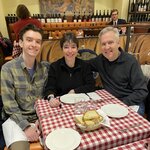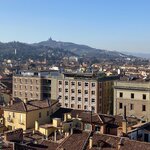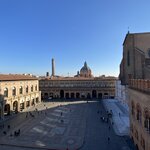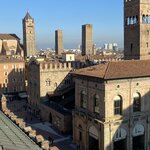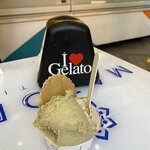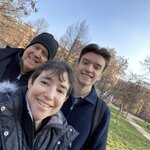Highlights
- Explore the world-famous Vatican Museums and Sistine Chapel
- Discover the sites of Tuscany's Pisa and Lucca
- Climb one of Rome's seven hills for views over the city
- Tour Florence's medieval piazzas, bridges, and cathedrals
- Browse through lively markets and taste local foods
Brief Itinerary
| Day | Highlights | Overnight |
|---|---|---|
| Day 1 | Arrive in Rome - Explore the city | Rome |
| Day 2 | Enjoy a guided tour of Vatican City and Rome | Rome |
| Day 3 | Take the train to Florence and discover the city with a walking tour | Florence |
| Day 4 | Day Trip to Lucca and Pisa | Florence |
| Day 5 | Depart Florence |
Detailed Itinerary
Day 1: Arrive in Rome - Explore the city

Welcome to Rome, known as the City of the Seven Hills! According to legend, Rome was founded by brothers Romulus and Remus in 753 BCE atop Palatine Hill. As the long-time center of the powerful Roman Empire, you'll find nearly 3,000 years of architecture, history, and culture throughout the city.
After arriving at one of Rome's airports, you'll transfer to your hotel in the historic center. Settle in and relax, then head out for a stroll and your first look at the Eternal City. The next few days will involve lots of sightseeing, so spend your first few hours enjoying some of the highlights. Suggested activities include:
- Visit the Catacombs of Priscilla, which were originally used from the 2nd to 5th centuries as burial grounds for the elite families of Rome. After the entrance was blocked for centuries to protect it from thievery, the catacombs were rediscovered in the 16th century. Visitors can see the original structures as well as paintings and artifacts from various time periods.
- Stroll through the tangle of narrow streets in Centro Storico, one of Rome's most historic districts, to see classical Roman and baroque architecture.
- Stop to see the Colonna di Marco Aurelio, a Doric column with a spiral of relief sculptures. It was erected in the 2nd century C.E. to celebrate the victories of the emperor Marcus Aurelius.
- Head to the Colle Aventino, one of Rome's famous seven hills. Stroll through the Roseto Comunale, the rose garden which sits on the site of a former Jewish cemetery. Then continue to Parco Savello (Orange Tree Park), where you can find the famous keyhole that gives visitors a direct view of the Vatican. Grab a cappuccino and snack from one of the adjacent cafes.
- For an authentic market experience, stop by the Mercato dei Fiori, where locals shop for fresh vegetables, flowers, meats, and cheeses. Browse for authentic Italian pasta and other souvenirs, then take a break with coffee and a pastry at one of the many cafes surrounding the market.
For dinner, head to the Trastevere neighborhood for some of the city's best trattorias.
Day 2: Enjoy a guided tour of Vatican City and Rome

Today you'll enjoy a 6-hour tour of Rome, starting with a visit to the Vatican City Museums and the Sistine Chapel. The Vatican is not only rich in history, but also in art, housing some of the most important Renaissance masterpieces in the world. You'll visit the Pio Clementio Museum, plus the Gallery of the Candelabra, the Gallery of Tapestries, and the Gallery of the Geographical Maps.
Continue through the museums to the Raphael Rooms, where you can admire the frescoes before entering the incredible Sistine Chapel and St. Peter's Basilica. Your guide will help you experience the allure of Renaissance art by divulging secret details and untold stories throughout the tour.
Afterward, continue your tour by visiting some of Rome's most notable landmarks. Cross Piazza della Repubblica to see the Fountain of the Nyands, then continue to the Trevi Fountain and the Palazzo di Montecitorio, which was designed by Bernini. If you have time, walk over to the Roman Forum, where you can find excavated temples and squares dating back 2,000 years.
On your way back into the city center, stop to admire the exterior of the Pantheon, then head inside for a look at the ancient Roman temple. Continue to Palazzo Madama—the Senate seat—and end in the lively Piazza Navona.
Finish your evening with a stroll through the piazza, stopping for some pizza, gelato, and people-watching.
Chat with a local specialist who can help organize your trip.
Day 3: Take the train to Florence and discover the city with a walking tour

Enjoy your morning with breakfast at your hotel and one final stroll around the neighborhood. Then catch your train to the city of Florence.
Spend the afternoon exploring the city's top sites with a guided, half-day walking tour. You'll stroll through Florence's historic center, passing by Piazza della Repubblica and the nearby Cathedral of Santa Maria del Fiore, the symbol of the city which is known for its terracotta dome. The picturesque cathedral is flanked by Giotto's Bell Tower and the Baptistery with impressive bronze doors. Get lost in its exterior tile, or head inside to admire its sculptures, art, and crypt.
For the rest of the day, you can continue your exploration of the city at your leisure. Some suggested activities include:
-
Stroll through the Galleria dell'Accademia, which displays Michelangelo's 'David' sculpture.
- Head to Studio Artemisia, located steps away from the Ponte Vecchio for a class in ancient fresco-painting techniques.
- Visit the Mercato Centrale, a 19th-century open-air market, to browse for a wide selection of vegetables, fruits, meats and cheeses, and a variety of lunch spots.
- Take a walk through the peaceful Boboli Gardens to see the oval-shaped Isolotto, a small island surrounded by various sculptures and lots of greenery.
In the evening, stroll around the Piazza della Signoria in front of the Palazzo Vecchio. Enjoy some gelato and people-watching, followed by dinner and drinks in the hip Sant'Ambrogio neighborhood.
Day 4: Day Trip to Lucca and Pisa

Go beyond the Leaning Tower and explore a bit of Tuscany on a full-day tour to the cities of Lucca and Pisa. You'll leave Florence with a private driver and head west, first stopping in Lucca, a city famous for the Renaissance walls that encircle its historic center. On a guided tour, you'll stroll its cobbled streets and stop at highlights like the Piazza dell' Anfiteatro public square—built over the site of an ancient Roman amphitheater—and the 11th-century Diavolo Bridge. Take a break to enjoy a coffee and pastry on the square.
Continue your tour of Lucca with stops at the medieval Torre Guinigi, the Torre dell Ore towers, and the San Michele in Foro basilica, built in the eighth century over an ancient Roman forum. End your visit with the 11th-century Duomo di San Martino, which was rebuilt in the 14th century in Gothic style.
Head south to Pisa, a city known for its iconic tower. However, your guided tour will reveal that there is much more to Pisa, starting with the Santa Maria della Spina Church, a Gothic gem set on the riverside. Stroll through the historic center of Pisa, admiring its medieval walls and stopping into a bistro for lunch. Then visit the Pisa Botanical Gardens, which are the oldest university botanical gardens in the world.
End your time in Pisa with a stop at Piazza dei Miracoli to see the famous Leaning Tower. The tower itself is actually the bell tower of the city's impressive Romanesque cathedral, Cattedrale di Pisa. Many don't know that this 183-foot (56-meter) marble cylinder has been leaning ever since its construction in 1372.
After the tour of Pisa, you'll return to Florence.
Day 5: Depart Florence

Your exploration of Italy will end after breakfast, with a transfer to the airport to catch your flight home or to your next destination.

